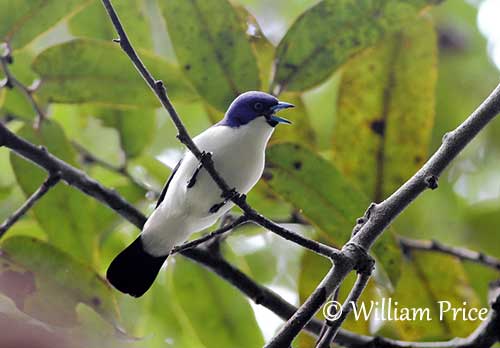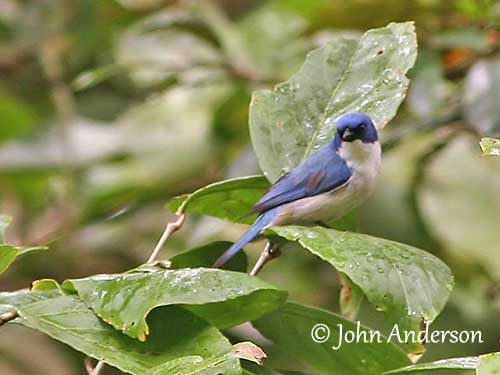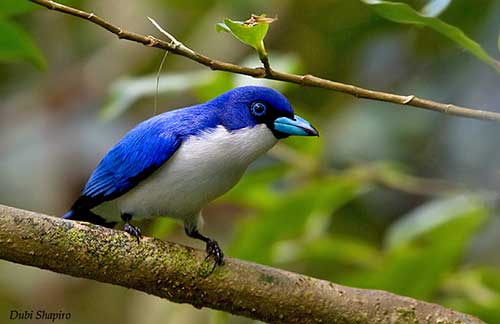
PROTECTION / THREATS / STATUS:
The Madagascar Blue Vanga is relatively widespread and common throughout its range on Madagascar.
It can be seen at the edge of the spiny forest, but it is usually absent from S and SW drier regions, and it is very local on central plateau.
This species is vulnerable to forest fragmentation, but it is present in several protected areas.
The Madagascar Blue Vanga is not globally threatened and currently evaluated as Least Concern.
Fr: Artamie azurée
Ang: Madagascar Blue Vanga
All: Blauvanga
Esp: Vanga Azul
Ita: Vanga azzurra
Nd: Blauwe Vanga
Sd: blåvanga
Mal: bolokibe, Pasasatrala, Raisasatra, Sarahesa, Vorontsara-elatra
Photographers:
John Anderson
John Anderson Photo Galleries
William Price
PBase-tereksandpiper & Flickr William Price
Dubi Shapiro
Dubi Shapiro Photo Galleries & Dubi Shapiro's Pictures on IBC
Text by Nicole Bouglouan
Sources:
HANDBOOK OF THE BIRDS OF THE WORLD Vol 14 by Josep del Hoyo-Andrew Elliot-David Christie - Lynx Edicions – ISBN: 9788496553507
Birds of Madagascar: A Photographic Guide Par Pete Morris, Frank Hawkins – ISBN: 0300077556, 9780300077551- Editeur: Yale University Press, 1998
Birds of Madagascar and the Indian Ocean Islands Par Roger Safford, Adrian Skerrett, Frank Hawkins – ISBN: 1472924118, 9781472924117- Editeur: Bloomsbury Publishing, 2015
Birds of the Indian Ocean Islands Par Ian Sinclair, Olivier Langrand - ISBN: 1868729567, 9781868729562- Editeur: Struik, 2003
The Birds of Africa: Volume VIII: The Malagasy Region: Madagascar, Seychelles, Comoros, Mascarenes - Par Roger Safford, Frank Hawkins – ISBN: 1408190494, 9781408190494- Editeur: A&C Black, 2013
Creagus – Bird Families of the World – Vangas - Vanginae
THE VANGAS OF MADAGASCAR by Nick Garbutt
Mystery bird: Madagascar blue vanga, Cyanolanius madagascarinus
Madagascar Blue Vanga
Cyanolanius madagascarinus
Passeriformes Order – Vangidae Family
INTRODUCTION:
The Madagascar Blue Vanga is now included in the endemic bird species of Madagascar since it became a full species separated from C. comorensis. It frequents the woodlands of the island, and exceptionally mangroves in the west. Like other vangas, it feeds primarily on insects, but it regularly takes some berries too.
The Madagascar Blue Vanga is common throughout its range, and the species is not currently threatened.

The female resembles male but she is duller. On the white underparts, the breast shows sometimes a light pale orange wash.
The juvenile has mostly grey-blue head and upperparts. The eyes are brown and the bill is black.
RANGE:
The Madagascar Blue Vanga is common throughout the island, except on central plateau and drier south.
HABITAT:
The Madagascar Blue Vanga frequents a variety of woodland including the deciduous dry forest in the west, and the rainforest in the east of the island. It may be found in adjacent second growth, and occasionally in mangroves in W Madagascar.
The species is visible from sea-level up to 1,200 metres of elevation, and sometimes up to 1,600 metres in areas with large trees.
CALLS AND SONGS: SOUNDS BY XENO-CANTO
The Madagascar Blue Vanga gives repeated, harsh « teea teea teea » and a short, medium-pitched “scheet” used as alarm calls. It also utters a hard rattle “tcccccccch” also given repeatedly “chrr-crrk-crrk-crrrk-crk-crk”.
This “song” is sometimes given from tree top, and can be either slow or fast, with the first note usually higher-pitched.

BEHAVIOUR IN THE WILD:
The Madagascar Blue Vanga feeds primarily on insects such as Coleopterans and Orthopterans, and caterpillars. It is one of the few vanga species known to take regularly berries too.
This small, agile bird often hangs upside-down while foraging in middle and upper levels of trees. It forages in leaf clusters almost at the end of thin branches.
The Madagascar Blue Vanga forages in groups of up to 6 individuals, usually mixed-species flocks outside breeding season. But when nesting, it can be seen in pairs.
Information is not currently available about the breeding behaviour and the displays of this species.
The Madagascar Blue Vanga is sedentary in its range.
Like other vangas, this species has short, rounded wings, and only performs short distance flights.
REPRODUCTION OF THIS SPECIES:
The breeding season probably occurs at least in October/November.
Only one nest was found and described, a cup-shaped structure made by both mates with fine twigs and a pale-coloured lining inside. This nest was placed near fork in tree, about 12 metres above the ground.
The female lays pale bluish/greenish eggs with darker speckles. From an observation, a dependent juvenile fed by the male was observed in November. No other information.

DESCRIPTION OF THE BIRD:
Biometrics:
Length: 16-19 cm
Weight: 19-25 g
The Madagascar Blue Vanga is a beautiful blue and white bird. The male has blue upperparts and head, and pure white underparts and throat but the undertail feathers are black.
On the upperparts, the flight-feathers are blackish and the blue tail has black terminal band.
On the head, crown, nape, cheeks and ear-coverts are blue, but there is some lilac wash on crown and nape. We can see a black area around the eye, extending narrowly around the base of the bill including the chin. Another black line is visible on the rear of the ear-coverts.
The bill is pale blue with black tip and cutting edges. The eyes are pale blue. Legs and feet are blackish.
